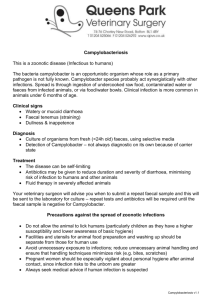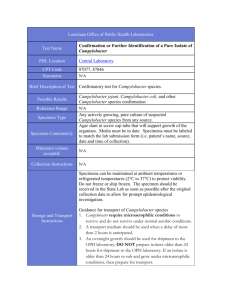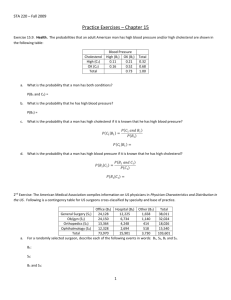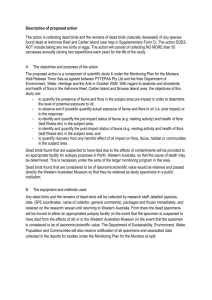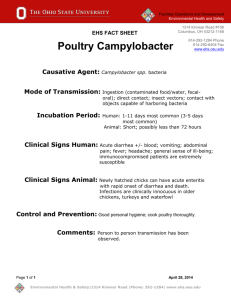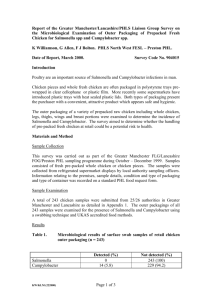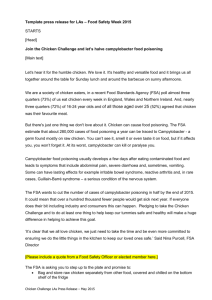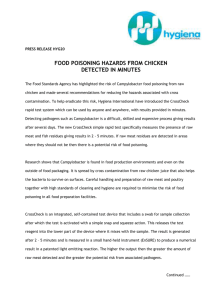evaluation of ce treatment against campylobacter regarding the
advertisement
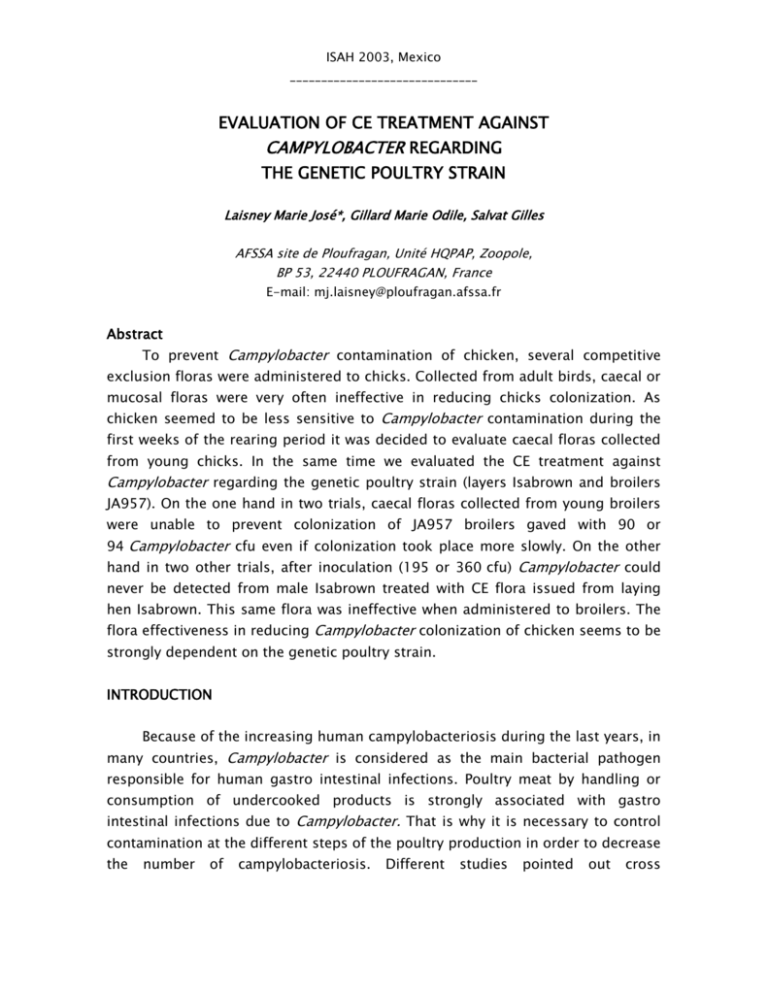
ISAH 2003, Mexico ______________________________ EVALUATION OF CE TREATMENT AGAINST CAMPYLOBACTER REGARDING THE GENETIC POULTRY STRAIN Laisney Marie José*, Gillard Marie Odile, Salvat Gilles AFSSA site de Ploufragan, Unité HQPAP, Zoopole, BP 53, 22440 PLOUFRAGAN, France E-mail: mj.laisney@ploufragan.afssa.fr Abstract To prevent Campylobacter contamination of chicken, several competitive exclusion floras were administered to chicks. Collected from adult birds, caecal or mucosal floras were very often ineffective in reducing chicks colonization. As chicken seemed to be less sensitive to Campylobacter contamination during the first weeks of the rearing period it was decided to evaluate caecal floras collected from young chicks. In the same time we evaluated the CE treatment against Campylobacter regarding the genetic poultry strain (layers Isabrown and broilers JA957). On the one hand in two trials, caecal floras collected from young broilers were unable to prevent colonization of JA957 broilers gaved with 90 or 94 Campylobacter cfu even if colonization took place more slowly. On the other hand in two other trials, after inoculation (195 or 360 cfu) Campylobacter could never be detected from male Isabrown treated with CE flora issued from laying hen Isabrown. This same flora was ineffective when administered to broilers. The flora effectiveness in reducing Campylobacter colonization of chicken seems to be strongly dependent on the genetic poultry strain. INTRODUCTION Because of the increasing human campylobacteriosis during the last years, in many countries, Campylobacter is considered as the main bacterial pathogen responsible for human gastro intestinal infections. Poultry meat by handling or consumption of undercooked products is strongly associated with gastro intestinal infections due to Campylobacter. That is why it is necessary to control contamination at the different steps of the poultry production in order to decrease the number of campylobacteriosis. Different studies pointed out cross ISAH 2003, Mexico ______________________________ contaminations via the slaughterhouses (Rivoal et al. 1999, Newell et al. 2001). Consequently the more poultry batches free of campylobacter could be delivered to the slaughterhouses the more we could limit the contaminations. The strict application of hygienic measures as sanitary barriers all over the rearing period seems to be one important way to prevent chicken contamination. Yet for some farmers it is quite difficult to respect this hygienic barriers and from time to time Campylobacter from the environment can enter the rearing house and consequently colonize the chicken. Then, others measures (such as the use of Competitive Exclusion flora) have been considered to prevent chicken colonization by Campylobacter. Several CE floras (caecal, mucosal) have been collected from healthy adult chicken, free of any pathogen bacteria, and were administered to young chicks. Unfortunately caecal and mucosal floras even when collected anaerobically and subcultured (Stern et al., 2001) were not as efficient to prevent Campylobacter colonization as they did to prevent Salmonella colonization of chicken. In previous studies (unpubished data) we tried to prevent Campylobacter colonization of broilers using a mucosal CE flora collected anaerobically from the caeca of adult SPF chicken. No difference was observed in Campylobacter contamination of several batches of chicks reared in isolation units, some of them being treated with mucosal flora at D0. Campylobacter (up to 107 cfu/g) could be detected in the caeca of birds (control as well as treated birds) sacrified seven days after inoculation. Because of the inefficiency of floras collected from old birds, we wanted to test the efficacy of caecal floras collected from young birds (i.e. 3 ,7, 10 days old) to take into account the fact that during the two first weeks of the rearing period Campylobacter are scarcely detected from the birds. We hypothesize that young birds are less sensitive to Campylobacter colonization probably due to the immature flora of the first fifteen days. In the same time we also wanted to test the possible role of the avian genetic strain in Campylobacter colonization resistance. So we collected caecal flora from young layers or from young broilers and administered them to birds reared in isolation units. Four trials were done. MATERIAL AND METHODES Chicken Two different genetical strains from commercial hatcheries were choosen: a layer strain (Isabrown) and a broiler strain (JA957). ISAH 2003, Mexico ______________________________ Isolation Unit "Glove box" isolaters were used for animal rearing. Feed without antibiotic and coccidiostat is delivered to birds and the drinking water is sterilized. Get in or get out of the birds, material needed for treatments or samplings, took place via a sas filled with quaternary ammonium compound. According to the trials, five to six isolation units were used. Caecal flora Three batches of CE floras were collected anaerobically from the caeca of birds Briefly : after sacrifying the birds, the caeca were aseptically removed, placed in a sterile flask and immediately introduced in an anaerobic chamber. Then after opening the caeca, the content was poured into flask and diluted (1/10 weight/volume) in TGY broth (15% glycerol). The diluted floras were dispensed into polypropylene round bottom tubes and then stocked in a deep freezer (- 72°C) until use. In the same time, the flora was checked for the presence of Campylobacter. Origin of CE treatment: Young hen (Isabrown) caecal flora collected on D3, D7 and D10 (February 2001): trial 1-trial 4. Chicken (broiler JA957) caecal flora collected on D3, D7 and D10 caecal flora collected on D3, D7 and D10 (February 2001): trial 2. Chicken (broiler JA957) (September 2001): trial 3. Challenge Campylobacter strain In the 4 trials the same Campylobacter jejuni strain isolated from an environmental sample of a rearing chicken house was used for the challenge. Birds placement in isolation units Before birds placement, swabbings of the isolation units were realised. Drinking water and feed were also sampled for Campylobacter detection. Furthermore on delivery day, swabbings of the transport crates were done and some chicks sacrified for analyse. Within some hours, chicks are shared out amongst the isolation units. ISAH 2003, Mexico ______________________________ Birds treatment As soon as the birds are placed in different isolation units every two days until D20, the CE flora was administered by oral gavage of 0.1ml to each treated bird. In the same time 0.1ml of sterile water was delivered to the others (negative and positive controls) in order to take the stress gavage into account. Birds challenge After subculture on blood agar (24-48 h, 42°C, microaerophilic atmosphere) the Campylobacter jejuni strain was inoculated into a Brucella broth (incubation 18 h). Then several dilutions were done to provide about 102 103 cfu to each chick except negative controls. Exact title of the suspension given to the birds was determined by plating on blood agar and Karmali Agar. All the birds, except negative controls, were inoculated on D15. Sampling (Table I) In each trial chicken from isolation units were sacrified and caeca removed aseptically for Campylobacter detection. Campylobacter methodology All the samples (caeca, droppings, feed) are diluted (1/10) into Preston broth and the swab tissues into 150 ml broth. Two selective media (Butzler n°2) and Karmali were used for direct plating (100 µl). Furthermore Campylobacter numeration was realised with a spiral plater system on Karmali media (incubation 48-72 h 42° microaerophilic conditions). On the other hand an enrichment procedure in Preston Broth was applied (18-24 h). Then streaking of the enriched broth was realised onto Butzler n°2 and Karmali media. RESULTS AND DISCUSSION Result expression Colonization rate (Stern et al., 2001) The colonization rate was calculated by dividing the number of birds colonized by the organism, by the number of birds challenged with the organism. Colonization factor Mean log 10 cfu Campylobacter per g in caeca of positive birds within each group. In our study we decided that the amount of Campylobacter/g of caeca was ISAH 2003, Mexico ______________________________ 100 when Campylobacter could be only detected after an enrichment period and 1 Campylobacter/g of caeca analysed when they were not. Protection factor Ratio of mean log 10 of Campylobacter per g in caeca of positive control chicks to corresponding mean for treated birds. Caecal flora No campylobacter could be detected from caecal floras. Challenge strain Trial 1: 190 cfu/chick Trial 2: 90 cfu/chick Trial 3: 94 cfu/chick Trial 4: 360 cfu/chick. Chicken (Table II) Whatever the trials, before challenge, no Campylobacter was detected. Furthermore negative controls remained Campylobacter free all over the rearing period. Campylobacter challenge succeeded in colonizing the positive controls. Two days after inoculation, all the birds of positive controls are not contaminated but within four (trial 3) or six days (others trials) the colonization rate observed is 1 and on the sixth day we noticed colonization factors ranging from 6.48 to 8.40. When the chicken were treated with CE flora the result depend on the trial and especially on the avian commercial strain. In trial one no Campylobacter could be isolated in Isabrown chicken caeca (layer strain) given caecal flora collected on D3, D7 and D10 from young laying hens. Similar results were observed in trial four when young chicks Isabrown were treated with the same seven day competitive exclusion flora as in trial one. Yet on trial four this caecal flora was not effective to prevent Campylobacter colonization of broiler JA957. Furthermore (trial 3 and 2) administration of CE flora collected (on D3, D7 and D10) from broilers did not protect chicken of the same commercial broiler strain from Campylobacter contamination. Six days after inoculation all the birds were contaminated (contamination rate: 1) and colonization factors ranged from 7.13 to 8.84. Nevertheless in trial 2, contamination of treated chicken took place later compared to the contamination of positive controls. Two days after challenge, protective factor is greater than 4 when using competitive flora (id D3 and D7). The efficiency of the competitive flora seemed to be better when flora is collected from younger chicken. ISAH 2003, Mexico ______________________________ In the four trials, experimental model was satisfying because Campylobacter quantities as low as 90 to 360 cfu administered per gavage to the fifteen days chicks (layer and broiler) were able to colonize the intestinal track of the birds reared in isolation units. Inoculation of 102 bacteria to one day chicks gave the same result in Young and al., (1999) trials but our model seems to be closer to the field conditions. The colonization ability of the Campylobacter jejuni strain collected from the environment of a broiler house resulted in colonization of caeca up to 108 Campylobacter without any symptom of illness for the contaminated birds. As well as for Stern et al. (1990) we noticed that the ability of the Campylobacter strain to colonize the chicken is strongly dependent on the avian strain: in our study Campylobacter colonization of the layer hens Isabrown is delayed compared with broiler JA957. The efficacy of CE flora collected from young birds was different according to the trials and the chicken. In two trials when Isabrown chicken (layer strain) were treated with the CE flora collected from young laying hens, no Campylobacter could be isolated from the caeca of these birds sacrified two, six and even twelve or sixteen days after inoculation but they were for positive controls. Stern (1994) noticed that efficacy of MCE treatment decreased with storage of the culture after 3 or 9 months of conservation in deep freezer (- 80°). At the opposite the laying hen CE flora we used was efficient to prevent Campylobacter colonization of the Isabrown chicken even after 11 months storage at – 72°C. Nevertheless the broiler chicken (JA957) could not be protected from Campylobacter contamination when treated with this flora. In the same way, Stavric et al. (1992) showed that layer and broiler could be protected from E. coli contamination but the protection was better in layers. That is why we think a genetic factor does exist. In our studies the commercial laying strain (Isabrown) provided from the hatchery was protected from Campylobacter contamination when a CE flora from young laying hen of the same commercial strain was used. Using CE flora from young broilers for limiting Campylobacter colonization of chicks JA957 was not as effective as we thought. Even if beneficial effect was observed 2 days after inoculation in one trial, this effect could not be confirmed in an other trial perhaps because of the CE flora origin. In fact, in this trial, CE were collected from chicken reared under experimental conditions different from those observed under commercial practices. In order to confirme that genetic factors are involved in Campylobacter colonization of chicken, it would be interesting to test the efficacy of broiler chicken CE flora administered to layer chicks and to check several avian commercial strains using our experimental model. ISAH 2003, Mexico ______________________________ REFERENCES 1. Newell D.G., Shreeve J.E., Toszeghy M., Domingue G., Bull S., Humphrey T. and Mead G. (2001). Appl. Environ. Microbiol., 67, 2636-2640. 2. Rivoal K., Denis M., Salvat G., Colin P. and Ermel G. (1999). Appl. Microbiol., 29, 370-374. 3. Stavric S. (1992). Int. J. Food Microbiol., 15, 245-263. 4. Stern N.J. (1994). Poultry Sci., 73, 402-407. 5. Stern N.J., Cox N.A., Bailey J.S., Berrang M.E. and Musgrove M.T. (2001). Poultry Sci., 80, 156-160. 6. Stern N.J., Meinersmann R.J., Cox N.A., Bailey J.S., Blankenship L.C. (1990). Avian Dis., 34, 602-606. 7. Young C.R., Ziprin R.L., Hume M.E. and Stanker L.H. (1999). Avian Dis., 43, 763-767. Table I: Caeca samples Isolation units Trial 1 D1 D15 D1 D1 D2 D2 D2 D3 4 7 Negative controls 5 10 Positive controls 5 inoculati 9 1 3 7 1 5 5 5 10 10 4 4 10 10 5 5 10 11 5 5 10 10 5 5 10 10 10 9 10 10 10 10 10 10 10 7 10 10 10 7 on Chicks Isabrown treated Flora D3 10 inoculati on treated Flora D7 10 inoculati on treated Flora D10 10 inoculati on Trial 2 Negative controls 5 Positive controls 5 inoculati on Chicks JA 957 treated Flora D3 5 inoculati on treated Flora D7 5 inoculati on ISAH 2003, Mexico ______________________________ treated Flora D10 5 inoculati 10 10 10 on Trial 3 Negative controls 5 Positive controls 5 Chicks JA 957 inoculati 5 5 5 5 5 5 5 5 5 5 5 5 5 5 5 5 on treated Flora D3 5 inoculati on treated Flora D7 5 inoculati on T- (JA957 et Isabrown) Trial 4 T+ (JA957) 10 5 inoculati 20 20 10 12 10 11 10 11 10 10 on Chicks JA 957 and Isabrown T+ (Isabrown) 5 JA957 treated Flora D7 5 inoculati on Isabrown treated Flora D7 5 inoculati on 10 ISAH 2003, Mexico ______________________________ Table II : Colonization rates, colonization factors and protection factors TRIAL 1 TRIAL 2 TRIAL 3 TRIAL 4 Chick Isabrown Chick JA 957 Chick JA 957 Chick JA 957 Isabrown T+ trait trait trait ed ed T+ ed trait trait trait ed Flor Flor Flor ed ed trait trait JA9 Isab JA9 Isab ed Flor Flor Flor ed Flor Flor a a a a a a a a D3 D7* D1 D3 D7 D1 D3 D7 0 D1 T+ 57 . T+ T+ 57 . trait trait ed ed FD7 FD7 0 * * cfu 190 190 190 190 90 90 90 90 94 94 94 360 360 360 360 CR 0,1 0,0 0,0 0,0 1,0 0,3 0,4 0,8 0,2 0,6 0,6 0,6 0,0 0,2 0,0 0 0 0 0 0 0 0 0 0 0 0 0 0 0 0 0,4 5,9 1,1 1,4 4,3 1,0 1,6 0,9 3,2 2,2 9 4 0 8 0 6 0 2 3 4 5,4 4,0 1,3 0,6 1,1 1,4 0 1 8 6 5 4 1,0 1,0 5 D 17 CF PF D CR 1,0 0 0 0 CF 6,9 6,7 5,6 8 8 2 1,0 1,2 3 4 19 PF D CR 21 CF 1,0 0,0 0,0 0,0 1,0 1,0 1,0 1,0 1,0 1,0 1,0 1,0 1,0 1,0 0,0 0 0 0 0 0 0 0 0 0 0 0 0 0 0 0 6,5 8,4 8,7 8,5 8,5 7,2 7,2 7,1 8,1 7,9 8,0 2 0 8 8 6 PF D 0 3 0 6 3 0,9 0,9 0,9 1,0 1,0 1,0 7 8 8 0 2 2 1,0 1,0 1,0 0 0 0 7,7 7,0 7,3 5 8 0 1,0 1,0 9 6 CR 23 CF PF D 27 CR 1,0 0,0 0,0 0,0 1,0 1,0 1,0 1,0 0 0 0 0 0 0 0 0 0 ISAH 2003, Mexico ______________________________ CF 2,4 7,6 8,3 8,8 8,8 7 3 5 4 2 0,9 0,8 0,8 1 6 7 PF D CR 31 CF 1,0 0,0 0,0 0,0 1,0 1,0 1,0 1,0 0 0 0 0 0 0 0 0 6,4 6,6 8,7 8,1 7,9 8 9 1 3 2 0,7 0,8 0,8 7 2 4 PF * same flora
